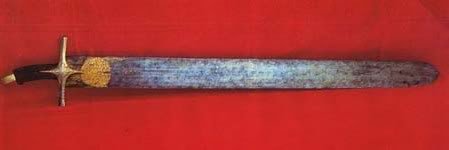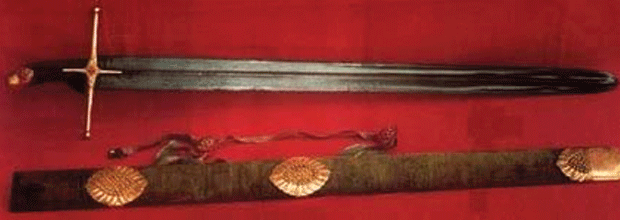
'Wash the blood off my sword, daughter! It served me well today!'
The Life of Muhammad by Ibn Ishaq
Appendix 2: The Swords of the Prophet
The names of the Prophet’s swords
The Prophet Muhammad is said to have personally owned nine named swords. Eight of them are housed in the Topkapi Palace, Istanbul. The ninth, Al-Adb, is in Cairo, Egypt.
1. Al-Mathur, The Received
1. Al-Mathur, The Received
This is said to be the first sword that the Prophet owned and is said to be the one that he inherited from his father and brought with him to Medina in 622CE.
Modern reproductions of this beautiful sword al-Mathur are available for sale from Oryx Gift Trading, where it is described as being 99 cm long, having a straight blade with a pointed tip, and an octagonal gold-plated hilt, cross-guard and scabbard studded with rubies and turquoises.
2. Al-Adb, or Azab, The Cutter, or The Sharp One
2. Al-Adb, or Azab, The Cutter, or The Sharp One
According to Al-Tabari, the Prophet had ‘two swords with him when he came to Medina, one of which was called al-Adb (the Sharp) and which he used at the Battle of Badr.’
However, most other sources are agreed that the Prophet brought with him the one sword, al-Mathur, and that al-Adb was given to him by Sa’d b. Ubada.
Traditionally, al-Adb is said to be the sword that the Prophet gave to Abu Dujana for use at the Battle of Uhud in March 625CE, and the sword on which Muhammad’s followers used to swear allegiance.
3. Dhu al-Faqar or Zulfiqar, the Piercer, or The Spine Cleaver
3. Dhu al-Faqar or Zulfiqar, the Piercer
Zulfiqar is a legendary sword, a double-edged sword with a split tip, presented to the Prophet by Ali who is said to have killed its owner Munabbih b. al-Hajjaj at the Battle of Badr in 624CE.
It is not known exactly what the sword looked like, and many differing curved designs with two wildly long tips have been invented for it over the centuries, and used as emblems and on banners.
Zulfiqar is said to have had scallops along the length of the blade for easier cleaving of coats of mail. It would definitely not have been curved, though, because, in the time of the Prophet, only straight swords were used.
Swords seized as booty from the treasures of the Beni Qaynuka
After the Battle of Badr, the Prophet sent the Jewish tribe, the Beni Qaynuka, into exile for refusing to submit to Islam. They were forced to leave behind all their beautifully-crafted artefacts including all their weapons and goldsmith tools. According to al-Tabari, the three best and most historic swords fell to the share of Muhammad:
4. Al-Battar, The Trenchant
4. Al-Battar, The Trenchant
Believed by the Jews to have belonged to King David, al-Battar features a drawing of David cutting off the head of Jaloot (Goliath) and an inscription in ancient Nabatean script.
Al-Battar is also known as the ‘Sword of the Prophets’. It bears a later Muslim inscription in Arabic of the names of Islamic prophets ending with Yahya (John the Baptist), Isa (Jesus) and Muhammad. Some Islamic traditions say that Jesus will use this sword to kill Dajjal (the Anti-Christ) on the Day of Judgement.
5. Al-Hatif, The Deadly
5. Al-Hatif, The Deadly
It is claimed that al-Hatif was believed by the Jews to have been forged by King David himself and passed down the generations.
6. Medham or Al-Qalai, The Keen
6. Medham or Al-Qalai, The Keen
Al-Qalai bears a later inscription in Arabic: ‘This is the noble sword of the house of Muhammad the Prophet, the Apostle of Allah.’
Swords seized as booty from the temple at al-Fuls
In 630 CE, the Prophet sent Ali with a Muslim army of 150 men to subdue the Beni Tayyi. Ali attacked the inhabitants, took a number of men, women and children as captives, and took many camels and sheep as spoils.
Ali then destroyed the idol at al-Fuls (al-Qullus), and seized two swords that had been presented to the temple by al-Harith b. Abu Shimr.
Al-Tabari lists these two swords as being among the Prophet’s possessions. Al-Waqidi mentions a third sword, called al-Yamani, taken at the same time, which may have been given to or retained by someone else.
7. Al-Mikhdham, The Sharp
7. Al-Mikhdham, The Sharp
Al-Mikhdham is said to have been previously owned by al-Harith al-Ghassani, presented to the temple by al-Harith b. Abu Shimr.
8. Al-Rasub, The Penetrator
8. Al-Rasub, The Penetrator
Al-Rasub is also said to have been presented to the temple by al-Harith b. Abu Shimr.
The final sword
9. Al-Qadib, The Thin
9. Al-Qadib, The Thin
Al-Qadib is a thin-bladed sword resembling a rod, a defensive sword, never used in battle but kept in the house of the Prophet. Written on the side of the sword in silver is the inscription: ‘There is no God but Allah, Muhammad the apostle of Allah -Muhammad b. Abdallah b. Abdul-Muttalib.’
The Spears of the Prophet
The names of the Prophet’s spears
According to al-Tabari, Muhammad took three spears and three bows from the weapons of the Beni Qaynuka. However, al-Tabari does not name the spears.
Some sources say that the Prophet took two spears, al-Monthari, the Disperser and al-Monthawi, the Destroyer, whilst according to others, the third and longest of the Prophet’s spears had the name of al-Bayda, The White.
The only record we have of Muhammad personally killing someone with a spear is at the Battle of Uhud when he killed Ubayda b. Khalaf. Ubayda’s brother, Umayya b. Khalaf, and his nephew, Ali b. Umayya, had been taken prisoner at the Battle of Badr, but instead of being ransomed, they had both been hacked to death by the Muslims. In revenge for this atrocity, Ubayda sought out Muhammad at the Battle of Uhud. Muhammad seized a spear from al-Harith and struck Ubayda in the neck, causing him to fall off his horse. Ubayda died on the journey back to Mecca.
The names of the Prophet’s half-pikes
Muhammad is also said to have had three half-pikes, named al-Afra, al-Nabah and al-Hafr, the first of which is said to have been presented to Zubayr b. Awwam by the Negus of Abyssinia.
The Anaza
Muhammad also owned a special short spear, called an Anaza, which he used as a staff, and which he used to plant into the ground in front of him to act as a sutrah (an object to show the direction of prayer and to prevent passers-by from interrupting concentration) when performing salat (prayer).
The Anaza became such an important symbol of the Prophet’s and then the Caliphs’ authority that it was later pictured on the first Arab-Sassanian coinage made during the Caliphate after the Muslim conquest of Persia.
The Anaza is shown as a vertical barbed spear with two pennants floating to the left or right, under an arch that can be interpreted as a mihrab (prayer niche). These rare and ancient coins, known as ‘Mihrab and Anaza’ drachma, are highly prized and fetch enormous prices at auction.
This Arab-Sassanian (Persian) drachma possibly minted in Damascus c75 AH (695? CE) dates from the time of Caliph Abd al-Malik b. Marwan after the Muslim Conquest of Persia. The bust of the former Shah of Persia, Khusrow, has an Arabic inscription added which includes the name ‘Muhammad Rasul Allah’ in the border divided by crescent moons and stars. The Mihrab and the Anaza are clearly depicted on the reverse.









